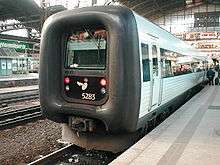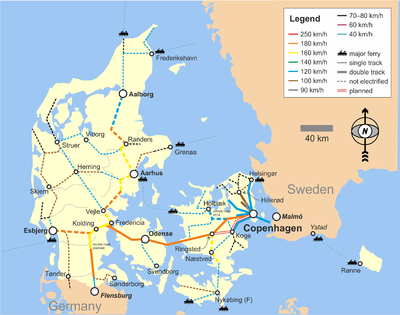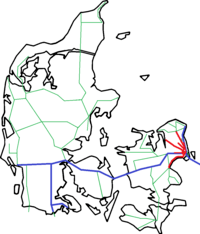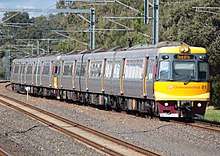Rail transport in Denmark
| Denmark | |||||||
|---|---|---|---|---|---|---|---|
 DSB IC3 | |||||||
| Operation | |||||||
| National railway | DSB | ||||||
| Infrastructure company | Banedanmark | ||||||
| Major operators |
DSB Arriva DB Schenker Rail | ||||||
| Statistics | |||||||
| Passenger km | 6.653 billion (2016)[1] | ||||||
| Freight | 2.575 billion tkm (2016)[2] | ||||||
| System length | |||||||
| Total | 2,560 km (1,590 mi) (2017)[3] | ||||||
| Double track | 976 km (606 mi)[3] | ||||||
| Electrified | 642 km (399 mi)[3] | ||||||
| Freight only | 30 km (19 mi)[3] | ||||||
| Track gauge | |||||||
| Main | 1,435 mm (4 ft 8 1⁄2 in) | ||||||
| Electrification | |||||||
| 25 kV 50 Hz | 450 km (280 mi) (2017)[3] | ||||||
| 1650 V DC (S-train) | 169 km (105 mi)[3] | ||||||
| 750 V DC (Metro) | 21 km (13 mi)[3] | ||||||
| Features | |||||||
| No. stations | 508 (2017)[3] | ||||||
| |||||||
The rail transport system in Denmark consists of 2,633 km of railway lines,[4] of which the Copenhagen S-train network, the main line Helsingør-Copenhagen-Padborg (at the German border), and the Lunderskov-Esbjerg line are electrified. Most traffic is passenger trains,[5] although there is considerable transit goods traffic between Sweden and Germany.
Maintenance work on most Danish railway lines is done by Banedanmark, a state-owned company that also allocates tracks for train operators. The majority of passenger trains are operated by DSB, with Arriva operating on some lines in Jutland. Goods transport is mainly performed by DB Schenker Rail, although other operators take care of a significant portion of the non-transit traffic.
Denmark is a member of the International Union of Railways (UIC). The UIC Country Code for Denmark is 86.
Tracks

Banedanmark is in charge of 2,045 km of railway lines,[3] which do not include the lines controlled by private railways. All Danish railways are 1,435 mm (4 ft 8 1⁄2 in) (standard gauge), with the exception of a few narrow gauge museum railways; 1,000 mm (3 ft 3 3⁄8 in) gauge was previously common on branch lines, with 700 mm (2 ft 3 9⁄16 in) being prevalent on industry railways, such as those for transporting sugar beets. The narrow gauge lines generally disappeared during the 1950s and 1960s.
The maximum speed allowed on main lines is generally 180 km/h, with less trafficked lines usually allowing between 75 and 120 km/h;[6] the speed may be lowered in places due to the condition of the track. While wooden sleepers are used on sidings and branch lines, concrete sleepers are the norm on all main lines; the common two-block concrete sleepers are now being phased out in favour of monoblock ones.
The age of the tracks in Banedanmark's network has become increasingly problematic in later years. A 2002/03 analysis of Banestyrelsen's (now Banedanmark) network states that the average age of the track is too high, with a present average age of 24 years compared to the recommended 20 years.[7]
Electrification
General-purpose electric propulsion was adopted quite recently in Denmark; the political decision to electrify the main lines was made in 1979.[8] The first line to be electrified was Copenhagen–Elsinore, electrified in 1986, followed by the main line across Zealand, Funen and Southern Jutland in the 1980s–90s. On the main lines that are equipped with them, the overhead lines carry 25 kV AC at 50 Hz. The system is used on the main line from Sweden through Copenhagen to Fredericia, and from there to Padborg and the German border.[9] 25 kV AC at 50 Hz is better from a technological point of view. However, both Sweden and Germany use 15 kV at 162⁄3 Hz and 16.7 Hz respectively, and the multi-system class EG goods locomotive is equipped for both 25 and 15 kV.
The S-train network in Copenhagen operates at 1650 V DC, supplied from overhead lines; the Copenhagen Metro uses 750 V DC, supplied from a third rail.
Since there are heavy delays (several years) with the construction of the new diesel multiple unit IC4, many debaters argue that it is better to electrify major railways and purchase electric multiple units instead, since that is a more common product. At least the route Fredericia-Ålborg must be electrified in order to run electric passenger trains between Jutland and Copenhagen.The route between Kolding-Esbjerg was due to be to open for electric trains in 2015. The government has in 2009 decided to delay all electrification for several years until the new signal system ERTMS is introduced, since electrification earlier than that requires rebuilding of the existing signal system.[10]
In September 2013 the government reached a deal with the Danish People's Party and the Red-Green Alliance (Denmark) to use additional oil taxes to create a train fund. This train fund would be used to electrify all of the main line trains by 2025, and increase train speeds to 250 kilometres per hour (160 mph) for InterCity trains. This would allow for travel between the cities of Copenhagen, Odense, Esbjerg, Aarhus, and Aalborg in four hours.[11]
On 29 May 2015 Banedanmark announced a 2.8 billion DKK (€375 million) contract to have Aarsleff-Siemens electrify 1300 km of tracks before 2026.[12]
Safety and signalling
Main lines were equipped with the ATC safety system during the 1990s, with a partial, cheaper implementation, ATC train stop, being used on some (but not all) branch lines. A different system, HKT, which was introduced in 1975 and utilises cab signalling, is used on the S-train network, although a simplified version, "forenklet HKT" (F-HKT), is used on some of the lines.[13]
Denmark has its own ATC system (ZUB 123), not compatible with other countries. It is a modification of the Swiss system. Trains crossing the border to Sweden or Germany have to have two ATC systems, and handle two electrical supply systems.
In order to replace the different and aging signal systems,[14] it has been decided to replace all current signal systems on Banedanmark's active network, except the S-train lines, with ERTMS level 2, relying entirely on cab signalling; general rollout is scheduled for 2018–21.[15] The S-train network is set to be refitted with a suitable urban rail system, possibly a CBTC system allowing driverless trains, by 2020.[15]
Connection to adjacent countries by rail
Denmark has railway connections to Sweden and Germany, both of which use the same rail gauge as in Denmark. The electric voltage is different as Sweden and Germany use 15 kV AC while Denmark uses 25 kV AC. The train protection systems are also different between all three countries. This means that locomotives must be specially modified to cross the borders, while railway wagons can freely cross the border if there is a suitable locomotive.
Connections to Sweden use the Oresund Railway across Oresund Bridge. Services include SJ's X 2000 service to Stockholm and Øresundståg commuter services to Malmö Central Station and beyond.
There are 3 connections to Germany. The Vogelfluglinie route, carrying EuroCity and ICE services, uses the train ferry from Rødby, Denmark to Puttgarden on the island of Fehmarn, Germany, and from there proceeds via Lübeck and Hamburg to Berlin. The second connection is over land at Padborg, which carries ICE, intercity, and regional trains to Berlin via Hamburg, and used to carry EuroNight and CityNightLine trains to Amsterdam via Cologne, Basel via Frankfurt, Munich via Nürnberg, and Prague via Berlin.[16][17] The last crossing is overland at Tønder, Denmark and Süderlügum, Germany, which connects to Niebüll.[18] The Rødby ferry and Tønder crossing allow only diesel powered trains, while the Padborg crossing is electrified.
Since November 2014, CityNightLine does not service Denmark anymore.[19][20]
Railway operators
Railway undertakings currently operating in Denmark:
- Arriva
- CFL cargo
- DSB
- Lokaltog
- Metro Service A/S
- MJBA – Midtjyske Jernbaner
- NJ – Nordjyske Jernbaner
- SJ AB (formerly Statens Järnvägar)
- DB Cargo
See also
Notes
- ↑ "BANE21: Rail transport of passengers by unit and type of transport". StatBank Denmark. Statistics Denmark. Retrieved 2018-06-20.
- ↑ "BANE1: Rail transport of goods by unit, type of transport and railway system". StatBank Denmark. Statistics Denmark. Retrieved 2018-06-20.
- 1 2 3 4 5 6 7 8 9 "BANE41: Railway network 1st January by railway system and unit". StatBank Denmark. Statistics Denmark. Retrieved 2018-06-20.
- ↑ "Statistikbanken". Statistics Denmark. Retrieved 2016-04-28.
- ↑ "Jernbanen i tal". Banedanmark. Retrieved 25 November 2008.
- ↑ For details, see the map at "Kort over jernbanenettet - Maksimal hastighed", Banedanmark. (PDF file available.)
- ↑ See "Analyse af Banestyrelsens sporanlæg - resume" (p. 2), Banestyrelsen. (PDF format.)
- ↑ Koed, Jan (1997). Danmarks Jernbaner i 150 år. Forlaget Kunst & Kultur. p. 203. ISBN 87-7600-199-7.
- ↑ For details, see the map at "Kort over jernbanenettet - Strækninger med el-drift" Archived 2005-09-01 at the Wayback Machine., Banedanmark. (Includes map of the S-train network; PDF file available.)
- ↑ Transportminister: Glem alt om flere elektriske tog de næste 12 år
- ↑ http://www.cphpost.dk/national/high-speed-electric-trains-2025
- ↑ https://web.archive.org/web/20151222144139/http://www.bane.dk/visNyhed.asp?artikelID=22316
- ↑ For details, see the map at "Kort over jernbanenettet - HKT togkontrol", Banedanmark. (PDF file available.)
- ↑ "Totaludskiftning af signalanlæggene - hvorfor?". Banedanmark. Retrieved 2009-05-13.
- 1 2 "The Signalling Programme" (PDF). Banedanmark. Retrieved 2009-05-13.
- ↑ https://web.archive.org/web/20100821152910/http://www.dsb.dk/Global/PDF/Koereplaner/International/International_Koereplan20jun_11dec_2010.pdf
- ↑ https://web.archive.org/web/20130717082550/http://www.dsb.dk/global/pdf/koereplaner/international/k13/intkpl_k13.pdf
- ↑ http://www.neg-niebuell.de/
- ↑ "Deutsche Bahn: City Night Line" (in Danish).
- ↑ "Das langsame Sterben der Nachtzüge" (in German).
External links
| Wikimedia Commons has media related to Train/Denmark. |
- Banedanmark
- DSB
- Arriva Tog
- Railion Danmark
- Rejseplanen - official search engine for all public transport by rail and bus in Denmark
- Winchester, Clarence, ed. (1936), "Denmark's modern transport", Railway Wonders of the World, pp. 1369–1374 illustrated description of Denmark's railways in the 1930s

